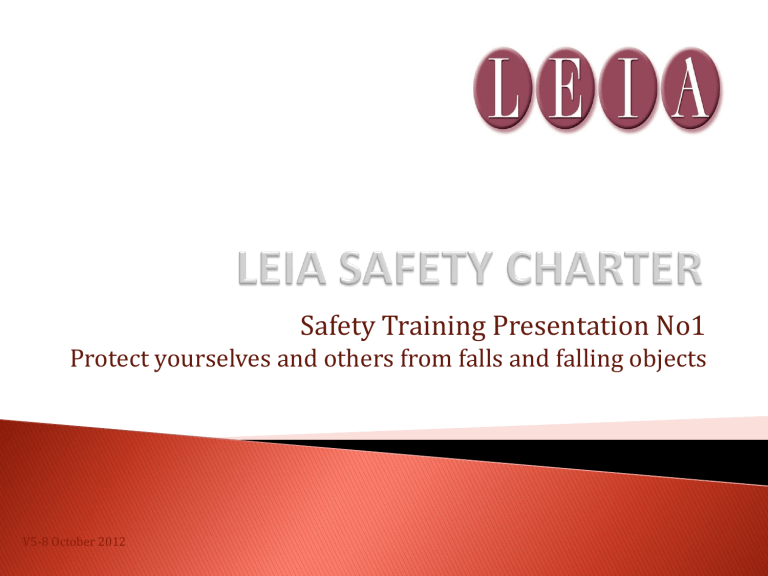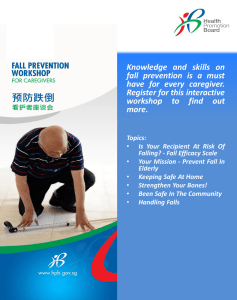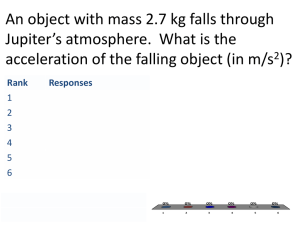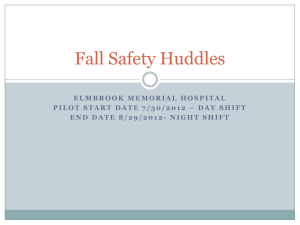- Lift and Escalator Industry Association

Safety Training Presentation No1
Protect yourselves and others from falls and falling objects
V5-8 October 2012
Accidents
Over the last 20 years there have been 12 fatal accidents within the lift and escalator industry
How have the fatal accidents occurred?
Falling from height and falling objects
Crushing/ struck by moving equipment
Electricity
2
3
43 fatalities in 2010 in UK (all industries).
Of these, 5 were from a height of less than 2m.
In the last three years there have been 13 major injuries and 23 over 3-day injuries attributed to falls from height and falling objects reported to LEIA.
4
Protect yourselves and others from falls and falling objects
Falls from Height - Definitions
The following definitions of equipment are used:
Fall Protection equipment –any equipment used to stop injury from a fall; include guardrails, screens, nets, air bags, work restraint systems and fall-arrest systems.
Fall Prevention equipment –any equipment which stops persons approaching a fall hazard; includes guardrails, screens and work restraint systems.
Fall Mitigation equipment –any equipment which reduces the harmful effects of a fall ; includes nets, air bags and fall-arrest systems
5
Protect yourselves and others from falls and falling objects
Falls from Height – Definitions
Work at Height–any work in any place, including a place at or below ground level where, if measures were not taken, a person could fall a distance liable to cause personal injury
6
Protect yourselves and others from falls and falling objects
Falls from Height - Hierarchy of Controls
General principles from the Work at Height Regs:
Avoid the work at height if possible.
If not possible or practicable then:
Prevent falls by collective measures.
◦ Example: vertical screens, horizontal extension of the car top, provision of guard rails.
◦ Guardrails on the edge of a flat roof.
If collective measures are not practicable then:
7
Protect yourselves and others from falls and falling objects
Falls from Height - Hierarchy of Controls
Prevent falls by personal measures
◦ Example: by harness and restraint lanyard restricting access to the fall hazard (Work Restraint)
8
Protect yourselves and others from falls and falling objects
Falls from Height - Hierarchy of Controls
Prevent falls by personal measures
◦ Example: by harness and restraint lanyard restricting access to the fall hazard (Work Restraint)
If, after provision of fall prevention equipment, falls are still possible then:
9
Protect yourselves and others from falls and falling objects
Falls from Height - Hierarchy of Controls
Mitigate consequences of a fall by collective
measures (ie put measures in place to minimise the distance and the consequences of a fall should one occur).
◦ Example: provide catch nets or air cushions.
If not possible or practicable then:
10
Protect yourselves and others from falls and falling objects
Falls from Height - Hierarchy of Controls
Mitigate consequences of a fall by personal measures.
◦ Example: provide a harness and fall-arrest lanyard
NOTE: the provision of personal fall-arrest measures must be seen as a last resort
11
Protect yourselves and others from falls and falling objects
Falls from Height - Hierarchy of Controls
Collective measures are always to be given priority over personal measures.
12
Protect yourselves and others from falls and falling objects
Falls from Height - Hierarchy of Controls
WORK
NETS /
AIR BAGS HARNESS/
LANYARDS
LADDERS & HOP-UPS
13
Protect yourselves and others from falls and falling objects
Falls from Height – Voids During Installation or
Modernization
950mm high guardrails, with a vertical gap of no more than
470mm and toe boards, should be fitted where there is a risk of falling...
Where this is not practicable, safety nets or sheets should be used...
Where this is not practicable, use a harness and lanyard to stop the person reaching the fall hazard (work restraint)...
When this is not practicable, fall arrest equipment must be used.
14
Protect yourselves and others from falls and falling objects
Falls from Height – Voids During Installation or
Modernization
950mm high guardrails, with a vertical gap of no more than 470mm and toe boards, should be fitted where there is a risk of falling
Where this is not practicable, safety nets or sheets should be used
Where this is not practicable, use a harness and lanyard to stop the person reaching the fall hazard
When this is not practicable, fall arrest equipment must be used
15
Protect yourselves and others from falls and falling objects
Falls from Height – Voids on Lifts in Service
A horizontal opening greater than 300x300mm from the edge of a platform or car top creates a risk of falling and must be reduced or protected
Where a space exists in which a person could fall, precautions shall be taken in the following order:
◦ Vertical Screen
◦ Horizontal extension of the car top
◦ Provision of balustrades on the car top
◦ A Safe System of Work, which might involve the use of appropriate personal fall protection system, e.g. work restraint.
(BS 7255:2012 Cl 4.17.2)
16
Protect yourselves and others from falls and falling objects
Falls from Height – Voids on Lifts in Service
A horizontal opening greater than
300x300mm from the edge of a platform or car top creates a risk of falling and must be reduced or protected
17
Protect yourselves and others from falls and falling objects
Falls from Height – Voids on Lifts in Service
Many companies have deemed the 700mm guardrail height currently in the EN81 Standards to be too low and require other fall protection systems to be used. EN81-20 when it is issued will require 900mm high guardrail.
Do not lean over or through the guardrail if you do not have a suitable fall protection system.
18
Protect yourselves and others from falls and falling objects
Falls from Height – Voids on Lifts in Service
If wearing Work Restraint or Fall Arrest systems, ensure you do not attach to the car whilst on the landing
Disconnect from the car before accessing the landing
Operate Stop switch if connecting to the car top
On the car top, do not attach to the shaft unless the unit is locked off and tagged out
On the car top, do not connect if the car is to be moved unless it is an observation or partly enclosed car(risk of snagging)
19
‘accessible’ from the landing. Are you creating a fall hazard when accessing it and how can you avoid it?
20
Protect yourselves and others from falls and falling objects
Falls from Height – Observation and Partly-enclosed
Lifts
Due to the unusual working conditions additional precautions should be taken when working on these
If protection against falling is not incorporated in the design of the car top, wear a safety harness and lanyard attached to a suitable anchor point
Care should be taken when the safety harness is worn when moving the car to avoid possible snagging of the lanyard, etc.
21
Protect yourselves and others from falls and falling objects
Falls from Height – Observation and Partly-enclosed
Lifts
If protection against falling is not incorporated in the design of the car top, wear a safety harness attached to a suitable anchor point
22
Protect yourselves and others from falls and falling objects
Falls from Height – Ladders
Work at height from ladders should be avoided wherever possible, and should be risk assessed before starting
They should be considered as access/ egress equipment and only used as a workplace for light work of a short duration
When in use, ladders should be secured in position eg for access into lift pits
Never over-reach from a ladder; move it to a better position
23
Protect yourselves and others from falls and falling objects
Falls from Height – Ladders
Before climbing, make sure that:
The rungs are clean
Your boots are not wet or oily
You can keep 3 points of contact at all times
Tools will not fall from your pockets or carrying bag
The bottom of the ladder is away from walkways where people could knock against it
(continued)
24
Protect yourselves and others from falls and falling objects
Falls from Height – Ladders
Before climbing, make sure that the ladder is:
Not overloaded
Not damaged in any way
On a firm level base
At the correct angle (4 vertical to 1 horizontal)
Securely fixed at the top, middle or bottom (or footed whilst this is being done)
25
Protect yourselves and others from falls and falling objects
Falls from Height – Moving Platforms in Shafts
A moving platform may be a special platform, a false car or the lift car itself. It is usually suspended in the well from a manual or power operated tackle or hoist.
Each has safety devices to arrest uncontrolled descent/ movement and methods of operation which it is essential to follow, as laid down by your employer
26
Protect yourselves and others from falls and falling objects
Falls from Height – Moving Platforms in Shafts
Summary of safety precautions:
Understand exactly how it is to be used
Regularly test any safety devices
Keep the platform clean and in good working order
Report any defects to your employer
(continued)
27
Protect yourselves and others from falls and falling objects
Falls from Height – Moving Platforms in Shafts
Summary of safety precautions:
Never overload it – refer to the load plate
Protect against overtravel
Ensure the controls are protected against accidental operation
Ensure the platform has guardrails on all four sides
28
Protect yourselves and others from falls and falling objects
Falls from Height – Fixed Scaffolding
Common faults in scaffolding:
Scaffolding not erected or altered and dismantled by a competent person
Scaffolding not inspected by a competent person at least every week and records kept
Platform not wide enough (min 600mm or three planks)
No toe boards or guardrails on a working platform
Inadequate support for the boards
(continued)
29
Protect yourselves and others from falls and falling objects
Falls from Height – Fixed Scaffolding
Common faults in scaffolding:
Guardrails too low or gap too big (min 950mm high, max
470mm gap)
Defective, missing or unsuitable boards
Obstructed gangways
Overloading
Slippery surfaces
No proper access ladders or stairs
30
Protect yourselves and others from falls and falling objects
Falls from Height – Fixed Scaffolding
Obstructed gangway
31
Protect yourselves and others from falls and falling objects
Falls from Height – Fixed Scaffolding
Scaffolding in the well:
Keep the working and intermediate platforms fully boarded
Only remove the minimum number of boards for roping etc. and replace as soon as complete
Ensure no fall hazards are created by your work
Ensure boards are fixed in place to prevent accidental movement
Ensure toe boards and guardrails are fixed to prevent people, materials or tools falling
32
Protect yourselves and others from falls and falling objects
Falls from Height – Mobile Scaffolding
Scaffold towers should be erected and inspected by a competent person before use and records kept
Towers should be inspected every seven days and records kept
Mobile scaffolding (or scaffold towers) must be of sufficient strength and stability for the purpose
Working platform should have guardrails and toe boards
(continued)
33
Protect yourselves and others from falls and falling objects
Falls from Height – Mobile Scaffolding
Maximum height to width ratios must be followed
◦ H not greater than 3xW used outdoors
◦ H not greater than 3½ x W used indoors
◦ Max height 12m unless 3xW outdoors or 3½xW indoors is less than
12m in which case use the smaller height
◦ W measured over the narrowest part of the frame (or outriggers, if used)
Follow manufacturer’s guidance and instruction
34
Protect yourselves and others from falls and falling objects
Falls from Height – Mobile Scaffolding H not greater than
3xW used outdoors or
3½ x W used indoors
W measured over the frame (or outriggers if used)
H
W
W
Over frame
35
Protect yourselves and others from falls and falling objects
Falls from Height – Mobile Scaffolding
Max 12m or
3xW outdoors or
3 ½xW indoors
Maximum height shall be 12m using outriggers unless
3xW outdoors or
3½ x W indoors is less than 12m in which case use the smaller height
36
Protect yourselves and others from falls and falling objects
Falls from Height – Mobile Scaffolding
Poor Example:
Scaffold tower too narrow, insufficient diagonal bracing, no guardrails or toe boards on working platform and no access ladder
37
Protect yourselves and others from falls and falling objects
Falls from Height – Mobile Scaffolding
Examine parts before use and reject any faulty parts
When moving the tower ensure it is level, the wheels are supported on a suitable surface, and are locked before use
Never move the tower with people, tools or materials on it
Position the tower to prevent over-reaching
Climb to the working platform using the integral ladder inside the frame
38
Protect yourselves and others from falls and falling objects
Falls from Height – Access Routes across Roofs
In many lift installations, access to machine rooms is gained by crossing roofs. This access should not present a risk to the safety of people who use it
Safe access and egress should be by permanently installed equipment that adequately controls any risk of a fall
If not, then action is required to install these facilities or to provide them whenever the work requires. This may include sufficient lighting to be able to see the hazards in the first place
39
Protect yourselves and others from falls and falling objects
Falls from Height – Access Routes across Roofs
Unprotected edge with trip hazard and no external lighting
40
Protect yourselves and others from falls and falling objects
Falls from Height – Access Routes across Roofs
Check to ensure that any surface or material adjacent to where you are working or accessing supports your weight and anything you may be carrying avoiding fragile roofs and skylights
Ideally, a safe access route should be indicated so that the route does not go within 2 metres of any fragile material or any unprotected edge
Duckboards should be at least 600mm wide with handrails to prevent falls onto vulnerable materials
41
Protect yourselves and others from falls and falling objects
Falling Objects
Under the Work at Height Regulations steps must be taken to prevent the fall of any material or object that may injure people
Where it is not reasonably practicable to take suitable steps to prevent the fall of material or objects, then action must be taken to prevent people being struck by the falling material or object
(continued)
42
Protect yourselves and others from falls and falling objects
Falling Objects
When working in the shaft, it is not considered safe practice for one person to be directly above another unless it is absolutely essential for the work to take place e.g. hoisting and fixing guide rails
In this case, protection e.g. netting/ scaffold boards/ rope upstands should be in place so that any fall of material or equipment does not injure the person working below
Lockable gates will restrict access when not required
43
Protect yourselves and others from falls and falling objects
Falling Objects
Lockable gates will restrict access when not required.
A hoarding may also be used
44
Protect yourselves and others from falls and falling objects
Falling Objects
Where lifts share a common shaft and no full height division screens are fitted, then any work on lift cars in adjoining shafts should be conducted with the cars positioned at the same level so that objects cannot fall onto adjoining lifts
Alternatively, the cars could be positioned at top and bottom of shaft and LOTO whilst work is undertaken on the lower car
(continued)
45
Protect yourselves and others from falls and falling objects
Falling Objects
Consider work in a machine room – rope hole voids may need protection to stop small tools and equipment falling through into the shaft.
When assessing the potential for falling objects, also consider small objects which may fall through gaps in the platforms or through mesh decking (e.g. coins falling from pockets)
46
Case Study
Engineer undertaking work on top of shaft equipment using a ladder on the top of the car…
47
300mm Gap
Ladder
48
Protect yourselves and others from falls and falling objects
Case Study
Engineer fell from ladder through the 300mm gap…
49
…with fatal consequences
50
Protect yourselves and others from falls and falling objects
Supervision
HSE advise that supervision arrangements must be appropriate and proportionate to the risk – work on or near to open voids, inexperienced staff etc…
Personnel under training need to be supervised
Auditing arrangements for peripatetic workers
Ideally a formal inspection when manager goes on site to review and record evidence of safe working procedure.
51
52
LEIA Safety Charter
Protect yourselves and others from falls and falling objects.
Use and verify Stop and other devices when accessing, egressing and working on car tops and in lift and escalator pits to ensure total control of the equipment.
Electrically isolate and lock off when power is not required and when working close to unguarded machinery.
53
LEIA Safety Charter
Now being incorporated into the new edition of the LEIA
Site Safety Handbook.
We ask you to sign in this handbook, to commit to the three elements of the Safety Charter
54
Thank You for attending
55







